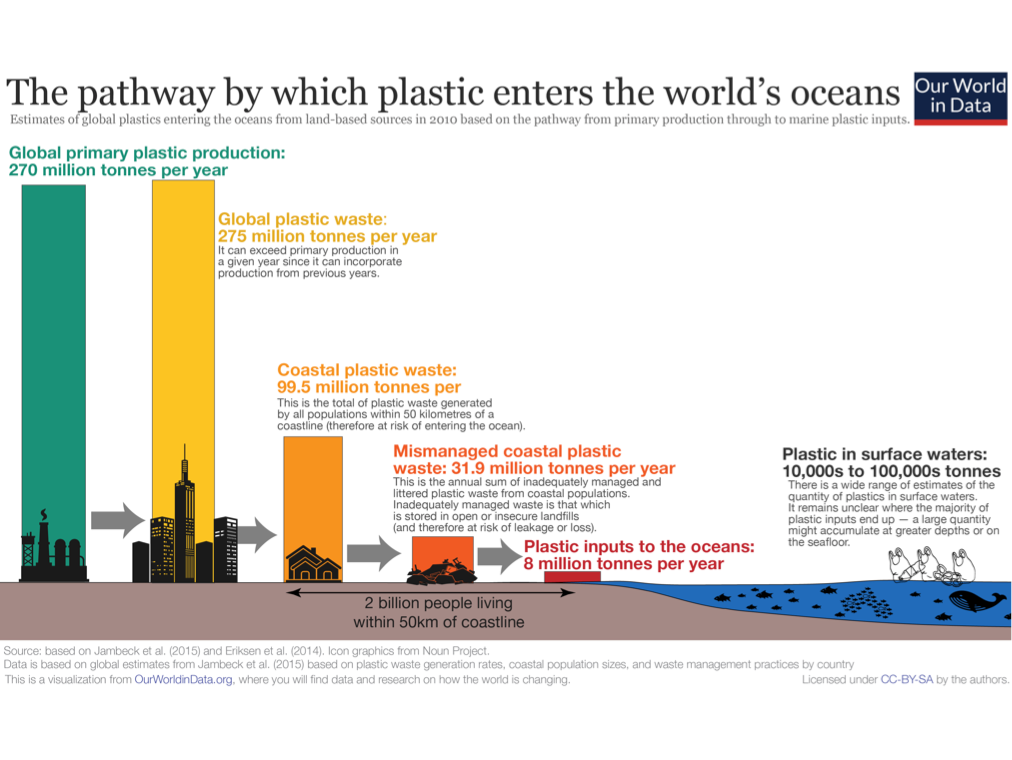The information here is provided by courtesy of the Network's short online course - "An Introduction to Global Health".
What are they and from where do they come?
Whilst there are some “natural plastics” e.g. casein in animal horns, cellulose in plants, resin in trees most plastics used today are man-made. The main source of man-made plastics is crude oil, though coal and natural gas are also used.
When crude oil is refined gases are produced which consist of single molecules (monomers). A process called polymerisation takes place when thousands of the monomers are linked together to form long polymer chains. These chains may be of different lengths and have different properties. They can be grouped into two main families :
- Thermoplastics, which soften on heating and then harden again on cooling
- Thermosets, which never soften once they have been moulded.
Broadly speaking, these two groups are the ones that have brought great benefits to our lives, but which are also a threat to the global environment.
How much plastic is being produced and what happens to it?
It was not until the 1950s that plastics were developed in any significant way, but plastic is now inextricably linked with the way in which we live. In 2015, 381 million tonnes were produced. The problem is that the lifespan of plastic is very long and, unless we address this, it will continue to accumulating on the planet. Have a look at the graph to see is production since the 1950s.

The benefits of plastics
Plastics have brought a large number of benefits to our lives that were previously not possible. Modern “Western” life could not exist without them. They are involved mainly in packaging, but also many other areas of our lives. 
What are the problems?
The problem is that they last for a very long time and, therefore, accumulate on the planet if not managed well.
Discarded thin plastics like plastic bags and sheeting can cause blockage of drainage systems on land. They are also transported to the sea by rivers and pollute the oceans.

In the oceans they can accumulate and cause damage to or be eaten by sea life. Tiny particles affect all organisms in the food chain from plankton to whales. When burnt in the open air they cause environmental pollution through the release of poisonous chemicals.
Managing plastic waste
Recycling and incineration are being increasingly used, but most plastics are still just discarded.

High income countries generate more plastic waste per person than low income countries, but they also have effective management systems. Low income countries tend not to have good waste management systems and the plastic either litters the countryside or ends up in the rivers and oceans.


Effects on human health
Whilst there is not yet good evidence about any damaging effects on human health, plastics will continue to accumulate as a result of their long lifespans and they damage the marine life and the environment.
The World Health Organisation has called for more research into the health effects of microplastics and for a crackdown on plastic pollution.
More information
The following websites provide more information
How plastics are made
https://www.plasticseurope.org/en/about-plastics/what-are-plastics/how-plastics-are-made
Plastic Waste Complete Guide (Excellent comprehensive guide)
https://cleanstreets.westminster.gov.uk/plastic-waste-complete-guide/
Fact sheet on plastics from UN
Single-use plastics: A roadmap for sustainability. 2018 Report, UN
https://www.unenvironment.org/resources/report/single-use-plastics-roadmap-sustainability
WHO Report on Microplastics in drinking water
https://www.who.int/water_sanitation_health/publications/microplastics-in-drinking-water/en/
WHO call for more research into microplastics
Natural History Museum
The museum has produced a series of YouTube presentations entitle "Our Broken Planet" that examine a variety of topics related to sustainability and pollution.
https://www.youtube.com/playlist?list=PL6w4ihPqk5_JPPgFuU8duzfnhlyO0WRgo
Greenpeace
https://www.greenpeace.org/usa/the-ocean-plastic-crisis/
Greenpeace website provides information about plastics and also the challenges we face around things like soya, deforestation, meat and dairy, the oceans, oil and pipelines, palm oil, the Antarctic, the Arctic, Fracking, peace, bees, fishing.
https://www.greenpeace.org.uk/challenges/
Our World in data has a section on plastics
https://ourworldindata.org/plastic-pollution




